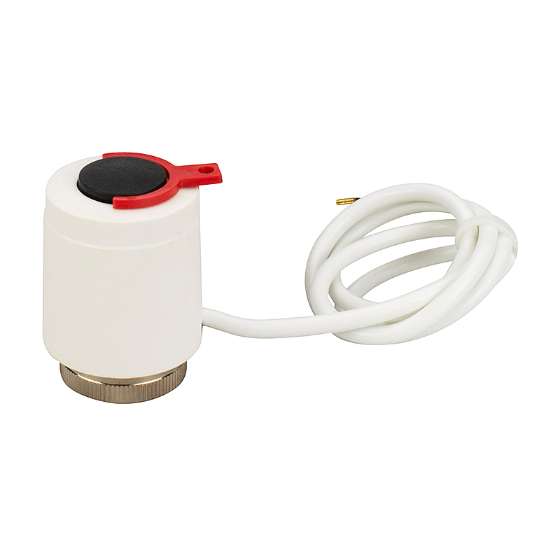
Thermal actuator
- Power consumption: 2-3 W
- Supply voltage: 230 V
- Size: M30x1.5mm
Innovative central heating control system
Dreaming of an automatic temperature regulation system in your house or apartment - without your involvement? Wondering how it can be done and what the cost of such a solution is? It's lower than you think!
All you have to do is invest in a small device - the thermal actuator. Soon, you will discover that it's a piece of equipment that you cannot live without!
Choose economy and comfort!
Lower heating bills shouldn't be just a dream. It can be a reality that you will decide on. A self-operational room heating control can help you reach a maximum savings level - something that your wallet will surely appreciate.
Different temperature in each room? As you wish
Did you know that humans feel and function best when they are in a room of the perfect temperature level? It means that you should set a different temperature for your bedroom, living room or bathroom. Complicated? Not at all! Simply use a thermal actuator, set the central heating system once and it will work as you need it constantly.
Undeniable quality
Precision of the construction and high-quality materials of great durability will make you forget the existence of the actuator for years. It's a 100% guarantee of efficiency for a long time.
A universal solution at the lowest price
Are you wondering how expensive the life-changing product is? We suggest an attractive price, adequate to the possibilities of the thermal actuator. It's a universal device which can be installed in central heating and floor heating distributors, as well as in traditional radiators. One product - a lot of possibilities!
Technical Specification
The most important features of the product:
- Material: Polypropylene
- Color: White
- Type: NC- Normally Closed
- Power consumption: 2-3 W
- Cord length: 80-100 cm
- Time for opening: 3-5 min
- Supply voltage: 230 V
- Size: M30x1.5mm
What is a thermal actuator?
An electric thermal actuator is one of the basic elements used for heating devices. It controls their functioning. It’s a very practical solution - an actuator can quickly affect certain elements of the heating system.
A thermal actuator is typically used when there is a need to control the temperature in a room automatically. It is worth noting there is a wide variety of thermal actuators on the market. For this reason, it is not difficult to find the right model for a system of traditional heaters or for floor heating. A thermal actuator is used definitely more often for floor heating systems.
A thermal actuator - how does it work?
The functioning of a thermal actuator is not a complicated process. It mostly depends on a thermostat, which reads the heat level in a room. If the temperature changes, the actuator receives a signal which prompts it to control the valves on the distributor.
If the temperature in a room rises above the level set in the thermostat - a signal is sent to activate the actuator and close the valve. In case of a temperature drop - the thermal actuator opens the valve.
The thermal actuator - structure
The most important part of the thermal actuator is its body, which contains the whole mechanism. This is where the power cord sticks out from. If needed, it can be extended - in compliance with the rules of electricity. It must be properly insulated.
The body of an actuator is usually made of a plastic material. Polypropylene is perfect for this purpose, because of its durability properties.
The outside of the element contains either a gauge or a handle which allows to control valve opening or closing.
Thermal actuator - how to choose the right type?
Because manufacturers offer a wide range of various equipment, one can easily find an electric thermal actuator to fit their individual needs and their heating system. Before deciding on a particular solution, one should consider several important aspects, which will allow to learn the class of a particular device.
The type of construction is a highly important matter. Most of the thermal actuators available on the market fit standard M30x1.5mm valves - but one should pay special attention to this feature. It might happen that one model is different in this regard.
Another important aspect is voltage. Usually it’s a universal parameter, therefore, a 230V thermal actuator is a popular product.
Speed rate - it’s something characteristic for modern devices. An estimated reaction time of a thermal actuator is at most 5 minutes. The shorter the time of waiting - the better.
Is power consumption of a thermal actuator an important feature? It might seem that the answer is no. However, the lower power consumption - the lower the maintenance costs. Energy use shouldn’t be higher than 5W - the best rate is 2-3W.
Why should you buy an electric thermal actuator?
A thermal actuator can help increase the functionality of the central heating in a building. It’s a solution which has a direct impact on the convenience of the system. How is it possible? A thermal actuator doesn’t require any sort of control from the user. It’s a perfect way to keep the ideal temperature level in a room, which also contributes to heating savings.
How to install a thermal actuator?
Because a thermal actuator is so easy to install, it’s something anyone can do. There is plenty of graphic guides and videos on how to do it in the web. What’s more, manufacturers often add their own instructions to the product.
How much does a thermal actuator cost?
The purchase of an electric thermal actuator is not a big expense, especially when one considers the advantages of such a solution. The simplest models available on the market are quite cheap. The more advanced and complicated the device - the higher the price.

 More information
More information